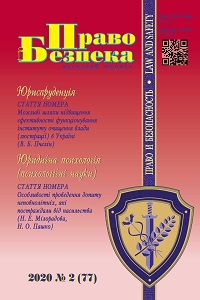Theoretical and Practical Aspects of Using Anatomically Detailed Puppets while Interrogating Extremely Vulnerable Persons
DOI:
https://doi.org/10.32631/pb.2020.2.03Keywords:
extremely vulnerable persons, rules and conditions of using anatomically detailed puppets, interrogation of minor victims and witnessesAbstract
The article is focused on one of the urgent tasks for domestic scholars and practitioners – the development and implementation of non-traumatic methods of interrogation. Thus, the author of the article defines theoretical and practical aspects of using anatomically detailed puppets during the interrogation of extremely vulnerable persons – minor victims and witnesses of rape, sexual abuse, corruption of minors, human trafficking, pornography, etc., including children with physical or (and) mental disorders.
The tactics of interrogation of these extremely vulnerable persons need to be improved through the introduction of the “Green Room” method declared by international and national standards, one of the elements of which is a set of anatomically detailed puppets. It has been noted that despite mentioning about the method of interrogation in the domestic normative, scientific and methodological literature, there are no detailed studies of the rules and conditions of using “Green Room” and the possibility of applying anatomical puppets.
Theoretical approaches and practical aspects of modern world experience of interrogating extremely vulnerable persons with the use of anatomically detailed puppets have been analyzed. It has been also determined that puppets are used as an anatomical model, demonstration aid, memory stimulation, diagnostic tool or “icebreaker” in the world theory and practice of interviewing children.
The author has determined the tasks of applying of the set of anatomically detailed puppets: 1) actualization of recollection; 2) visual demonstration by the child of the mechanism of criminal actions committed against the child; 3) increasing the reliability and significance of information about the circumstances of the commission; 4) prevention of secondary traumatization of minor victims and eyewitnesses of certain types of crimes.
The author has formulated the rules and has determined conditions for using anatomically detailed puppets during the interrogation of extremely vulnerable persons. The tactics of interrogation of minor victims and witnesses of certain types of crimes have been improved. The emphasis has been placed on the need for widespread introduction of this non-traumatic method of interrogation of minors into the training of future police officers, advanced training or (and) specialization of existing police officers, and into the investigative and judicial practice.
Downloads
References
Matiushkova T.P., 2019. Tactical peculiarities of an interviewing of the minors in an extremely vulnerable state [Taktychni osoblyvosti dopytu nepovnolitnikh u nadzvychaino-vrazlyvomu stani]. In: Dzhurak L.M. (ed.) Problems of ensuring human rights and freedoms [Problemy zabezpechennia prav i svobod liudyni]. Lutsk, 13 December. Lutsk: Vezha-Druk. Pp. 192-194.
Lamb M. E., Brown D. A., Hershkowitz I. et al., 2018. Tell Me What Happened: Questioning Children About Abuse. 2nd ed. Hoboken: Wiley-Blackwell.
Implementation of the best practices into the educational process [Vprovadzhennia peredovykh praktyk v osvitnii protses]. [online] Kharkiv National University of Internal Affairs. Available at http://univd.edu.ua/uk/news/5959 [Accessed 23 June 2020].
The usage of European experience in advanced training of investigators [Zastosuvannia yevropeiskoho dosvidu pid chas pidvyshchennia kvalifikatsii slidchikh]. [online] National Academy of Internal Affairs. Available at https://www.naiau.kiev.ua/news/zastosuvannya-yevropejskogo-dosvidu-pid-chas-pidvishhennya-kvalifikaciyi-slidchih.html [Accessed 23 June 2020].
Cherniei V.V., Husariev S.D., Cherniavskyi S.S. and Korolchuk V.V. (eds), 2020. Actual problems of pre-trial and trial investigation of crimes against sexual freedom and sexual integrity of children, ways to solve them [Aktualni problemy dosudovoho rozsliduvannia ta sudovoho rozhliadu zlochyniv proty statevoi svobody ta statevoi nedotorkannosti ditei, shliakhy ikh vyrishennia]. Kyiv, 19 June. Kyiv: Natsionalna akademiia vnutrishnikh sprav.
Puras D., Kalashnyk O., Kochemyrovska O. and Tsiuman T. (managers), 2015. Guidelines for interviewing children who have witnessed and / or been victims of violence and who have committed violence [Metodychni rekomendatsii shchodo opytuvannia ditei, shcho staly svidkamy ta/abo zhertvamy nasylstva, a takozh vchynyly nasylstvo]. Кyiv: FOP Klymenko. (Ed.: Tsiuman T.).
Morgan M. and Edwards V., 1995. How to interview sexual abuse victims. Including the Use of Anatomical Dolls. Thousand Oaks: Sage Publication.
Ceci S.J. and Bruck M., 1993. Suggestibility of the child witness: a historical review and synthesis. Psychol Bull, No. 113, pp. 403-439.
Katz S., Schonfeld D.J., Carter A.S., Leventhal J.M. and Cicchetti D.V., 1995. The accuracy of children's reports with anatomically correct dolls. Developmental and Behavioral Pediatrics, No. 16, pp. 71-76.
Saywitz K.J., Goodman G.S., Nicholas E. and Moan Sf.J., 1991. Children's memories of a physical examination involving genital touch: implications for reports of child sexual abuse. Consult Clin Psychol, No. 59, pp. 682-691.
Thierry K.L., Lamb M.E., Orbach Y. and Pipe M. E., 2005. Developmental differences in the function and use of anatomical dolls during interviews with alleged sexual abuse victims. Consult Clin Psychol, No. 73, pp. 1125-1134.
Poole D.A. and Bruck M., 2012. Divining Testimony? The Impact of Interviewing Props on Children’s Reports of Touching. Dev Rev, No. 32, pp. 165-180.
Poole D.A., Bruck M. and Pipe M.-E. Forensic Interviewing Aids: Do Props Help Children Answer Questions About Touching? Curr Dir Psychol Sci, No. 20, pp. 11-15.
Faller K., Grabarek M., Nelson-Gardell D. and Williams J., 2011. Techniques Employed by Forensic Interviewers Conducting Extended Assessments: Results from a Multi-Site Study. Journal of Aggression, Maltreatment & Trauma, No. 3, pp. 237-259.
Gundersen National Child Protection Training Centre, 2016. Anatomical Dolls and Diagrams: position paper. Winona.
The American Professional Society on the Abuse of Children et al., 1995. Use of Anatomical Dolls in Child Sexual Abuse Assessments. Columbus.
Everson M.D. and Boat B.W., 1994. Putting the anatomical doll controversy in perspective: An examination of the major uses and criticisms of the dolls in child sexual abuse evaluations. Child Abuse and Neglect, No. 18, pp. 113-129.
Ministry of Education and Science of Ukraine, 2014. Child development program from prenatal period to three years “Amulet” [Prohrama rozvytku ditei vid prenatalnoho periodu do trokh rokiv]. Ternopil: Mandrivets.



